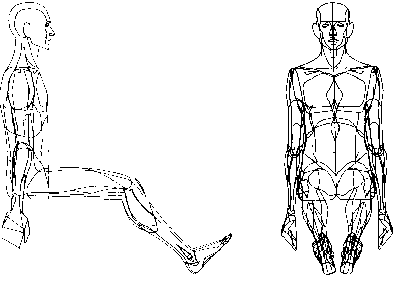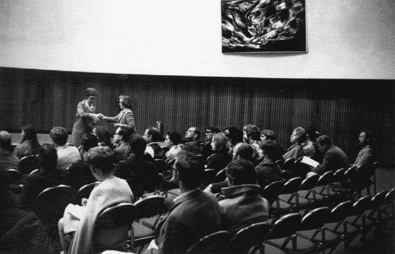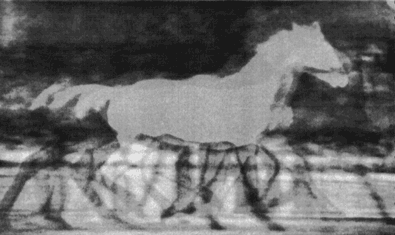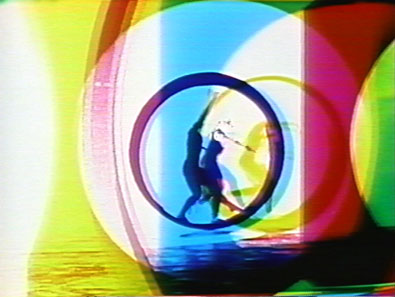
Seattle >
William Fetter (1928-2002), an art director
who worked for Boeing, was a computer graphics pioneer and the first to
draw the human figure using a computer (above). He was invited to attend
a meeting in 1965 at the Murray Hill, N.J. offices of Bell Telephone Laboratories
(now Lucent Technologies). As he remembers it, "this small group
was the entire population doing any form of computer graphics then and
I was the only one with an art background and an art degree. Surprisingly,
I was still the only one of this group doing perspective images. Some
present were Ken Knowlton and Ed Zajac of Bell Laboratories, George Michaels
and Bob Crowley of Lawrence Livermore National Laboratories, myself from
Boeing and others. E.A.T. was first described to me during a meeting in
New York at a conference and I felt the rich mix of art and technology
interactions already in progress in the Northwest might benefit by tying
in with that group. I contacted Dr. Kluver, obtained a film about their
show at the Armory in New York, and called a meeting of like-minded people
[in Seattle]."

The Northwest chapters of E.A.T. were founded in 1968 in Seattle and Portland.
The first meeting was held at the Seattle Science Center on June 29, 1968,
and was attended by 65 Oregon and Washington artists and technologists
(above). It was organized and run by William Fetter and LaMar Harrington,
with Doris Chase, Robert Brown, Jack Eyerly, and Don Paulson in attendance.
A film of "9 Evenings: Theatre and Engineering" made by Alfons
Schilling was shown that documented the performances. Two films made by
local artists also were screened: Sorcerer’s
Apprentice by William Fetter and Hans Graf, and Horses
by Robert Brown and Frank Olvey (later titled The
Tempest).
LaMar Harrington was Associate Director
of the Henry Art Gallery on the University of Washington campus. She first
heard about E.A.T. from artists who presented a photo show about Allan
Kaprow’s Happenings at the gallery. After establishing the E.A.T.
chapter, she presented individual and group art shows at the Henry Gallery
and Bellevue Arts and Crafts Fair that featured artists using new technologies.
They included the "Art and Machines: Motion Light Sound" show
in August, 1969 that featured new works by Hans Haacke, Doris Chase, Larry
Hansen, and others. She also presented films by Stan Van Der Beek and
Michael Snow (with live music by Philip Glass) and multi-artist gallery
and site installations. These included live music and outdoor happenings
by Steve Soreff, who choreographed earthmovers that were excavating the
University of Washington’s Red Square and the underground parking
garage near the gallery.

Film still from
The Tempest
Robert Brown and Frank
Olvey were active in the Seattle and Portland E.A.T. communities.
Their experimental film The Tempest received
awards from the Bellevue and Ann Arbor Film Festivals, was seen internationally
on television, distributed worldwide by the U.S. Information Agency, and
is in the collection of the Museum of Modern Art in New York. In 1968
Brown and Olvey won the first competitive State’s grant of $10,000
from the National Endowment for the Arts to "advance the art of filmmaking
in the Northwest," where they screened their films and discussed
their color film techniques in workshops throughout Washington and Oregon.
In 1969 they produced film sets for Turandot
with the Seattle Opera, and Cassandra for
Seattle’s New Dimensions in Music program, which was also shown
at the Composer’s Forum in New York City in 1970. Other intermedia
projects include Rooking for the Center for
New Performing Arts, University in Iowa, and America
for the Seattle Symphony. In 1974 their program was included in Stan Van
Der Beek’s series "The Future of the Image" at the University
of Florida, Tampa.

Film still from Circles
II
Seattle painter and sculptor Doris Chase
began collaborating with dancers, musicians, and filmmakers after the
first E.A.T meetings. She made many new works, including a dance sculpture
for a Seattle opera for children (Mantra)
and a computer-drawn series of circles that was transferred to film and
colorized by Seattle filmmakers Robert Brown and Frank Olvey, and set
to music by Morton Subotnick. To create Circles,
William Fetter arranged for Chase to use the computer graphics software/hardware
system he had been developing at the Boeing Company. Circles
was an artistic application of computer graphics programming accomplished
with the assistance of Robert Tingley, who worked with Fetter at Boeing.

Don Paulson
Northwest E.A.T. artist Don Paulson, a Seattle
painter, moved to New York City in the mid-1960’s where he hung
out at Andy Warhol’s Factory and attended the Velvet Underground’s
first public performance in 1966. Paulson returned to Seattle and in January
1967 founded and organized a group who performed the Lux Sit and Dance
lightshow in Seattle. Lux Sit ["Let there be light"] is a motto
on the University of Washington seal. This lightshow collective performed
in venues as diverse as the Seattle Opera House (for the Joffrey Ballet),
the Washington Athletic Club, and the Science Center. They worked with
some of the biggest bands of the day, including Jefferson Airplane, the
Byrds, and the Grateful Dead. Paulson is also an historian and has co-authored
a book about early Seattle gay culture, An Evening
at the Garden of Allah: A Gay Cabaret in Seattle (1996)

Gary Ewing
Portland >
After the first meeting of the E.A.T. chapter in Seattle, Jack
Eyerly organized a similar meeting in Portland the next day (June
30, 1968) at Patton Park. Eyerly was part of a family that invented and
built airplanes and amusement park rides. He had recently visited Vancouver,
Canada, where there was a new group of artists and technologists forming
called Intermedia, which was also based on the principles of E.A.T. The
Portland E.A.T. group was smaller, not supported by an art institution,
and was held together by Eyerly’s extraordinary networking, organizing
and writing skills. He wrote newsletters, organized public art events,
and helped connect artists with resources and people. One of the artists
to participate in the Portland group was Gary Ewing,
who began performing lightshows in San Francisco’s Avalon Ballroom
in 1965. He then moved back to his hometown in Portland. In addition to
performing lightshows, Ewing continues to work as a multi-talented artist
who designs posters and creates inflatable sculpture and other works of
art